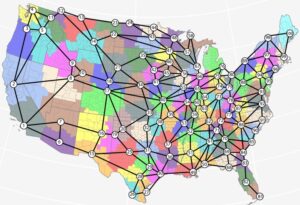RailNTA is a project led by CTSM in collaboration with the Federal Railroad Administration (FRA). The objectives of this project are to (1) implement and use a network analysis Python computer code, designed to quantifying the topological connectedness efficiency of freight railroad networks for resilience studies; (2) design the architecture of a Tool for Rail Network Topological Analysis and Throughput Assessment and; (3) use aggregate network to illustrate the methodology and the tools, and offer a proof of concept in coordination with FRA and industry partners.
Our analysis tools:
Our case studies:
References
- Hamed, M., Mao, Y., Ayyub, B.M., Elsibaie, M., and Omar, T., 2022, “Connectedness Efficiency Analysis of Weighted U. S. Freight Railroad Networks,” ASCE-ASME Journal of Risk and Uncertainty in Engineering Systems Part B: Mechanical Engineering, https://doi.org/10.1115/1.4054326.
- Saadat, Y., Ayyub, B.M., Helgeson, J., and Saleem, S., 2021, “Transportation Resilience Models for Supply Chain Analysis Using Complex Network Theory (CNT),” ASME Joint Rail Conference (JRC2021), April 20-21, 2021, https://event.asme.org/Joint-Rail-Conference.
- Mao, Y., Ayyub, B.M., Elsibaie, M., Saadat, Y., and Omar, T., 2021, “Optimizing Topology of Rail Networks: The Case of Reclassing, Acquisition and Repurposing of Tracks,” ASME Joint Rail Conference (JRC2021), April 20-21, 2021, https://event.asme.org/Joint-Rail-Conference
- Cao, S. Ayyub, B.M., Saadat, Y., Elsibaie, M., and Omar, T., 2021, “Topological Analytics for Vulnerability and Recovery Enhancements After Disruption of Rail Networks,” ASME Joint Rail Conference (JRC2021), April 20-21, 2021, https://event.asme.org/Joint-Rail-Conference
- Hamed, M.A., Ayyub, B.M., Elsibaie, M., Mao, Y., Saadat, Y., Omar, T., 2021, “Weights and their Consideration in Topological Analysis of Rail Networks,” ASME Joint Rail Conference (JRC2021), April 20-21, 2021, https://event.asme.org/Joint-Rail-Conference
- Zhang Y., Ayyub B.M., Saadat, Y., Zhang D., and Huang H., 2020, “A double-weighted vulnerability assessment model for metrorail transit networks and its application in Shanghai metro,” International Journal of Critical Infrastructure Protection, (29) 2020, 100358, https://doi.org/10.1016/j.ijcip.2020.100358.
- Saadat, Y., Ayyub, B. M., Zhang, Y., Zhang, D., and Huang, H., 2020, “Resilience-based Strategies for Topology Enhancement and Recovery of Metrorail Transit Networks,” ASCE-ASME J. Risk Uncertainty Eng. Syst., Part A: Civ. Eng., ASCE. 2020, 6(2): 04020017, https://doi.org/10.1061/AJRUA6.0001057
- Zhang, Y. J., Ayyub, B. M., Zhang, D. M., Huang, H. W., Saadat, Y., 2019. “Impact of Water Level Rise on Urban Infrastructures: Washington, DC, and Shanghai as Case Studies,” Risk Analysis, Wiley, https://doi.org/10.1111/risa.13390
- Zhang, F., Du, F., Huang, H., Zhang, D., Ayyub, B. M., and Beer, M., 2018. “Resiliency Assessment of Urban Rail Transit Networks: Shanghai Metro as an Example,” Safety Science, Elsevier, Volume 106, July 2018, Pages 230-243, https://doi.org/10.1016/j.ssci.2018.03.023.
Last update: 12/1/2022

